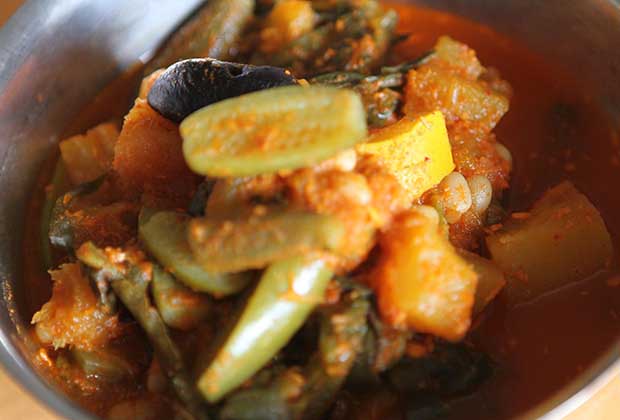Ganesh Chaturthi Special: Gajbaje Vs Khatkhate
- By Tara D TennebaumLoading...
- | 5 Sept 2016 10:03 AM IST
 X
X
 Gajbaje is typically prepared without onions and garlic. Photo: Tara Deshpande Tennebaum
Gajbaje is typically prepared without onions and garlic. Photo: Tara Deshpande Tennebaum
Khatkhate and Gajbaje are two great vegan stews of the Maharashtrian and Konkani diaspora, sadly undiscovered by many even within India. These robust, sweet and spicy curries are a nutritious medley of root vegetables, gourds and beans. They are replete with textures; crunchy beans, velvety yam and chewy drumsticks.
They are generally cooked without onions and garlic for religious occasions and especially for Ganesh Chaturti.
Gajbaje is also made for one of the holiest days in the Hindu calendar - Nirjala Ekaadashi. The story goes that while in exile the Pandavas survived on roots and tubers. Bheem who loved to eat would rustle up this stew before the Hindu day of fasting hence the holiday is also called Bheem Paas.
During this fast, rice is forbidden, so the stew is eaten with millet or wheat flatbreads.
For Ganeshotsav, it is accompanied by coconut rice called Keerli or semolina idlis.
Khatkhate is a Goan Saraswat Hindu dish. Konkan Hindus cook a similar dish called Gajbaje. While both stews look similar and share much in common they are prepared with different spices and techniques.
Recipes vary greatly among families. Some families may not use fenugreek seeds (they argue Ganesha doesn’t like bitter flavours), while others may prefer Kokum or Bilimbi (variant of star fruit) to Ambada (hog plums) as a souring agent.
Khatkhate finds its flavour in the classic Konkani masolu of red chilies and coconut, while Gajbaje is tempered (phodni) with mustard seeds.
These recipes make abundant use of the innumerable varieties of tubers, gourds and beans grown in Maharashtra. Depending on your geographical location some of this produce may not be available. You can substitute them with carrots, cooking potatoes, rutabaga, yam, sweet potato, butternut squash, parsnip, calabash, taro, taro leaves, amaranthus leaves, Swiss chard, kale, bamboo shoots, jackfruit, Chinese cucumber, navy, fava beans, cowpeas, green and white peas.
I don't use spinach - the flavour is too strong. The gourds can be also replaced with zucchini.
These stews are also called Kandamool - the generic Hindi term for root vegetables. Rushi chi bhaji made for Rushi Panchami, the day after Ganesh Chaturthi is also a great deal like Gajbaje and Khatkhate. My Khatkhate recipe is from my maushi in Goa and employs teppal or tirpal, a close cousin of the Sichuan pepper that gives the stew a distinctive, mildly astringent flavour that sets it apart from Gajbaje.
My kaki in Belgaum made a delicious Gajbaje. The vegetables are paired with tempered spices. She had several Ambade trees in her backyard so she soured everything with these Hog Plums instead of Kokum or Tamarind. She also used Marathi mogge, a kind of caper berry to add zing to the gravy.
Do you make Gajbaje and Khatkhate at home? Does the recipe change depending on the region you are from or the community? Are there local special ingredients you add to these stews?



